
This is how the poll ended. A whopping 75% of voters wanted to read a breakdown of “Back the the Future” and, what can I say, the People Have Spoken and I am happy to oblige.
My two cents on this: I believe that “Jaws” has the better script of the two. A more modern, darker take on “The old man and the sea” with “Moby Dick” influences, it’s an essential story but with many layers that deserve to be explored – including social and historical commentary – and richer characters. Well, maybe in a future post. In other words, it’s no “Sharknado” stuff. If I analyze the votes a bit, “Jaws” probably got the more intellectual vote (and probably, the segment aged 40+, because they were there when it hit).
But let’s face it, it was hard to beat the huge emotional and cultural impact of the 1985 insta-classic by Robert Zemeckis, which won by a landslide. Although as we will see in a moment, in some parts the movie didn’t really age that well.
Anyway, enough talk? Let the fun part begin!
*
1) Let’s start from the obvious.
Marty (Michael J. Fox) is the Hero. We get to meet him right from the introduction, 4 minutes of cinematography so well done that present the theme (a struggle against time), the context (Doc has been missing) and the main character without one single spoken word. A textbook execution of “show, don’t tell”.
We get to learn something about him: he is teenager, loves music, is not afraid to challenge the rules, is a bit of a rebel.

His life in the ordinary world is not bad – family is… well, very average, school sucks a bit, but he is in love with Jennifer (Claudia Wells) and she loves him back. All considered it’s not a bad life for a small town American teenager in the 80s.
While still in Doc’s workshop, Marty receives an early Call to Adventure. One he obviously doesn’t take so seriously.

Because his mind is busy on other things. School, love, but more importantly, the upcoming school audition.
In an early revealing conversation with the Principal Mr Strickland (James Tolkan), the theme is presented clearly: no McFly has ever done anything successful in the history of Hill Valley.
Marty is set to do something about it.

Or so he thinks. The audition goes wrong,

and he gets rejected. The members of the school board, not at all impressed by Marty’s performance, are acting as Guardians of the Threshold. They are (literally) there to test him.
(a little trivia here: the chief judge is… Huey Lewis, the singer of the memorable soundtrack songs “Power of Love” and “Back in Time“. He is also credited on Imdb)

The hero is weighed, and found lacking. He is not ready: he will need to undertake a quest in order to prove his worth. This is the moment in which it is established without the shadow of a doubt that the Ordinary World is too small for the Hero and his aspirations.
In the following conversation with Jennifer, Marty confesses that he lacks real confidence in his talents, and he doesn’t react well to failure. In this moment the tension is created between the theme (Marty wants to change the history of his family) and his fatal flaw.


It’s a very powerful struggle, and a classic. It’s a modern take on the Orpheus Myth: the mythical hero Orpheus, also a musician, takes an epic journey to the Underworld to change history and bring his wife back to life. Among many monsters and perils, the biggest challenge he faced was his own self-doubt.
Spoiler: he failed miserably, because ancient Greece is not Hollywood.
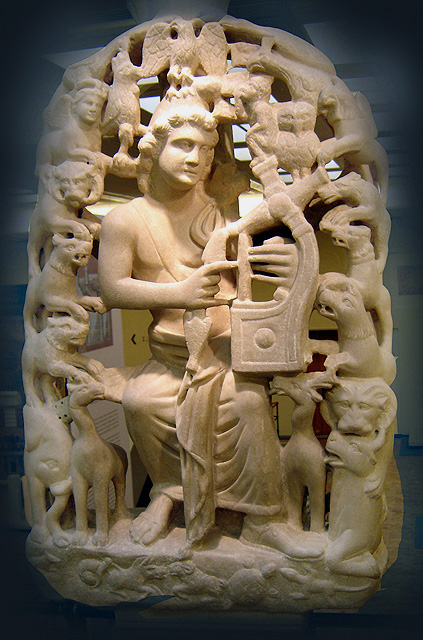
So, yes, with such powerful backstory, the scene is set, Marty’s heroic journey will be one of self transformation, and he will have to learn that, in order to really change history, he will have to defy limits, trust his talents in a series of all-or-nothing situations, and that sometimes NO is not an acceptable answer.
2) It’s time for adventure.
The inciting accident happens in the form of… an accident, literally (once again, the script by Zemeckis and Gale doesn’t play hide-and-seek):
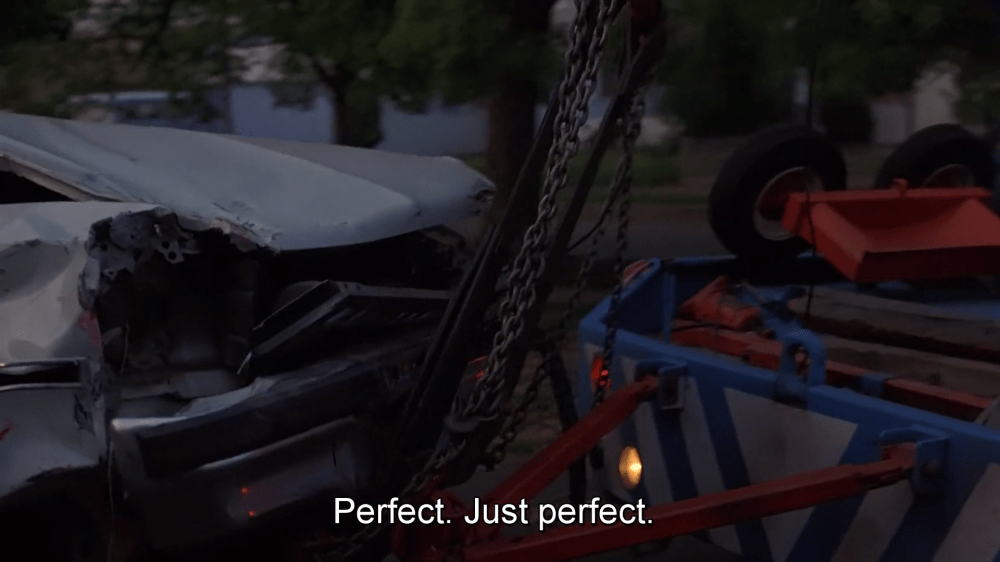
Marty gets home and learns that Biff (Thomas F. Wilson) – here introduced as Villain – has crashed the family car. The car he so badly needed for the date with Jennifer!
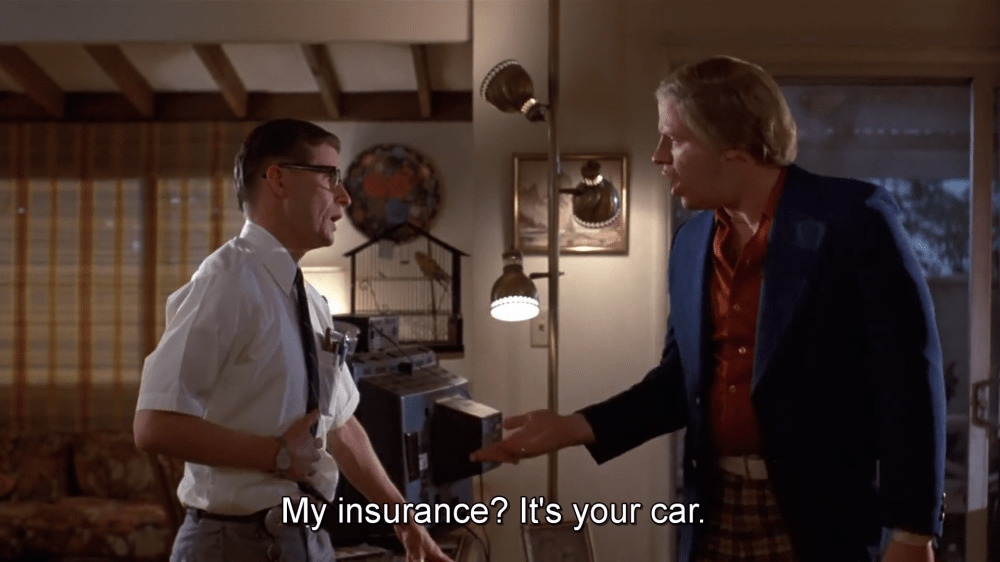
Marty is utterly depressed, we get to experience a little bit of his even more depressing family life, and then too much is too much.

He goes to bed dressed, and then another, more powerful call to adventure arrives. Once again, it’s Doc Brown on the phone!

In its linearity the plot continues to unfold in a very powerful way.
It’s late night and Doc and Marty meet in the parking lot of the Twin Pine Mall for an experiment. A Delorean car has been transformed into a time machine (if it sounds strange, think that… it may have been a lead-lined fridge, an idea that Spielberg used later in “Indiana Jones and the Kingdom of the Crystal Skull” (2008) – a mixed bag, really).
The experiment succeeds and Einstein the Dog is sent one minute into the future!
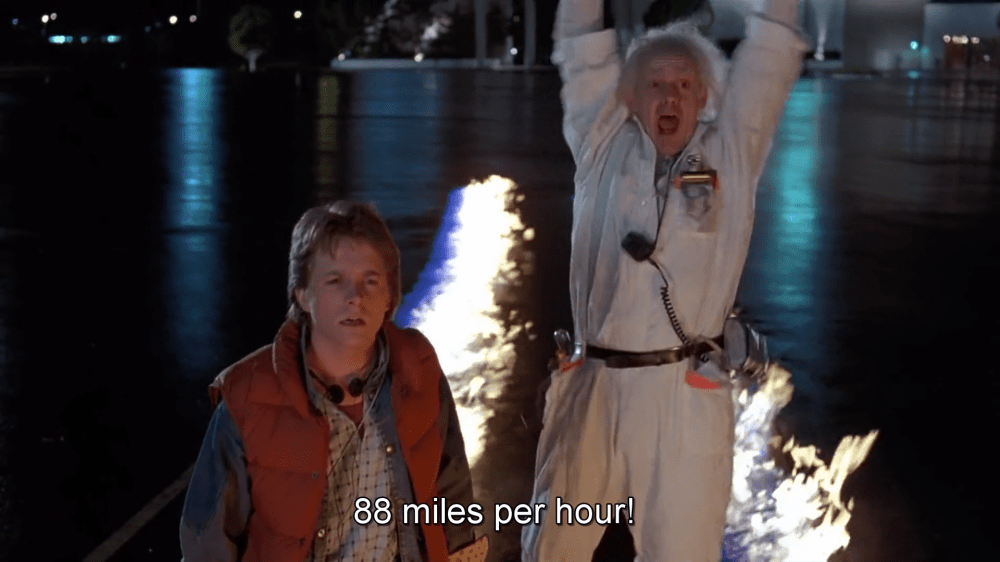
Doc illustrates his marvelous invention, at the same time revealing the moment that gave him the inspiration, it was 1955, and one night he slipped in the bathroom, hit his head, and had the sudden vision of the “flux capacitor”.
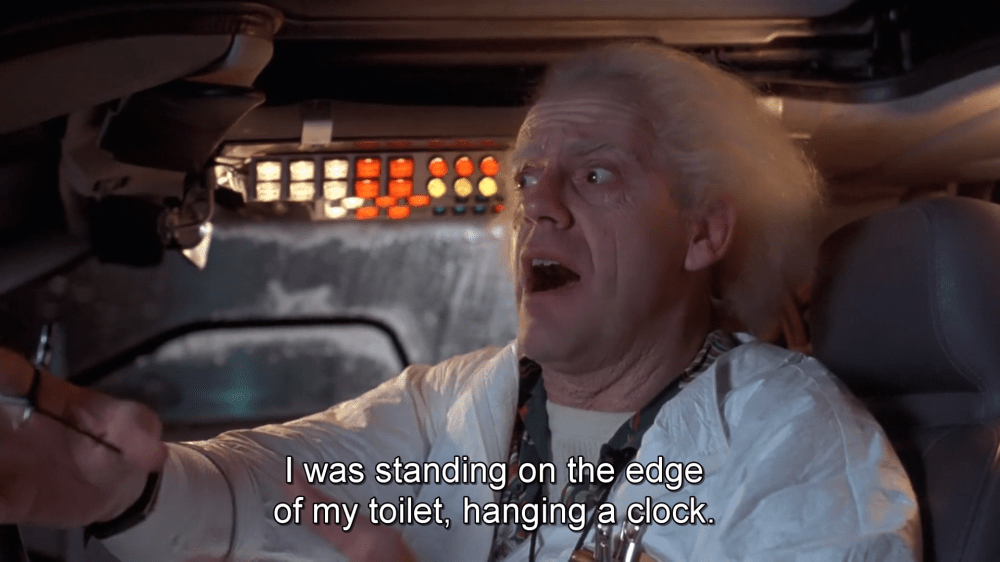
He also explains that the time machine doesn’t exactly run cheap. To activate the rather powerful 1.21 Gigawatt reaction necessary for time travel, a bit of plutonium is required. Great Scott! A new bar, each trip.
And Doc reveals that in order to obtain nuclear combustible, he had to play a dirty trick to a terrorist group. This is a necessary part of the story engine, as we will soon discover.

(BACKGROUND NOTE: back in 1985, a far-but-credible threat for the American audience were “the Libyans”. A bit like today’s ISIS, with less oil money. Here is a bit of context, for those who want to learn more. It’s a naive and insensitive narrative solution, displays a rather gross stereotype, but let’s just say that the plot gets away with it. I would really hope that modern screenwriters and storytellers can do a better job when representing “the enemy” – and sometimes they do; while some other times, well, they still fail miserably).
Doc explains to a still incredulous Marty the workings of the Delorean-turned-time-machine, and all is set for his final experiment, when… the terrorists!

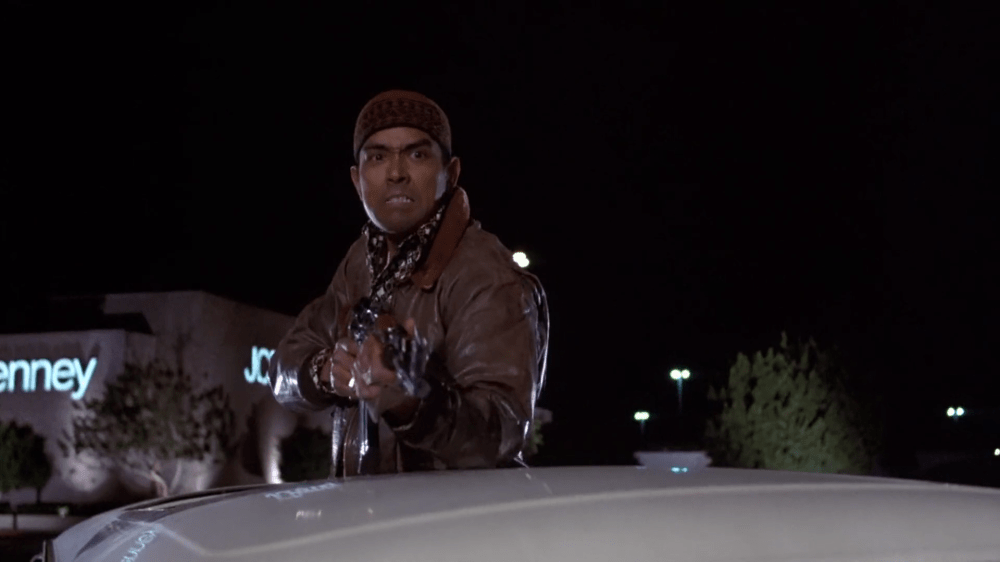
Now, this: it’s a cheap-ish deus ex machina and to a contemporary viewer, the scene of a meager group of 3 guys with a Kalashnikov, driving a Volkswagen van and yelling words in Arabic may seem rather ridiculous, if not a bit insulting. Rightly so.
How did they get there? How did they find him? Why a Volkswagen van? The audience is not really given time to process these questions – the suspension of disbelief is tested… but holds water, let’s say – as the bad guys corner Doc, and kill him brutally with machine gun fire.
Marty can’t do anything but witness as the scene happens, paralyzed with horror as his Mentor and friend dies.

The terrorists are after him, and he has no other choice than to jump in the Delorean. High speed car chase, the car hits the limit of 88 mph and whooom! – Marty is immediately teleported back in 1955 (the last date that was set on the display).

3) We are not in Kansas anymore.
A very literal Crossing of the threshold and Marty finds himself into the extraordinary world of 1955 Hill Valley.

Where he is… not exactly welcomed with open arms.
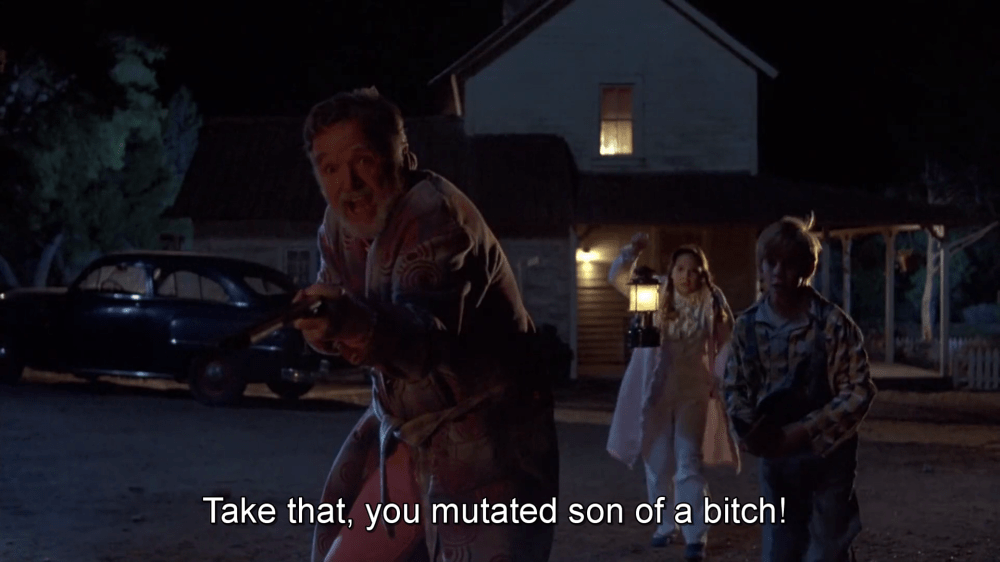
This marks the beginning of the second act, which is also clearly divided in two parts. The first is dominated by Marty’s surprise and wonder as he explores his new old world. After the initial refusal (again),

he will have to learn fast. “Pepsi free” and “Calvin Klein” were still brands unknown to public, and the idea of a Mayor of African-American descent sounded completely ridiculous – just like the notion of Ronald Reagan President of the US, for that matter. In the descending part of the plot, Marty will try to gain back control over the situation and his life.
4) Country road, take me home.
As he explores his road of trials, we encounter the friends and enemies that will populate the hero’s journey. Early on, Marty meets George, his young father (Crispin Glover) and Lorraine, his mother (Lea Thompson) – who will play a decisive role in the ordeal – as well as a younger Donald Trump Biff, who was acting as the school bully. But of course.

Two words on the Villain. The script does nothing to explore his character and background. This is a pity, because he is relegated to a rather bi-dimensional role of local bully who will establish a reign of terror, as long as he is unchallenged.
It serves the fast pace of the story quite well, but is a wasted opportunity, as nothing is done to investigate his backstory and understand Biff’s arc, at least a bit.
Other stories when this is done to perfection come to mind. In a similar setting (1950s “Americana”), think of Henry Bowers, the psychotic school bully of Stephen King’s “It”.
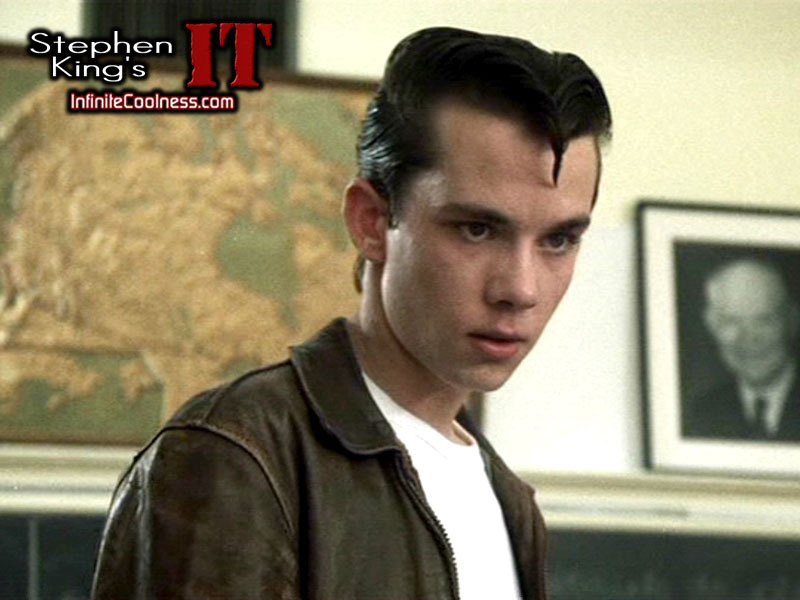
He is a bully who terrorizes the protagonist kids, but his personal life is a living hell. This can be established with a few quick strokes (nothing more than a few paragraphs in a novel; a brief scene in a film), but helps immensely in creating a more realistic, believable and deep character who will still serve as Antagonist, but at the same time raises feelings of empathy and understanding in the audience.
As heroes, we need to defeat the Biffs we encounter on our way; but wouldn’t it be better if we built communities where bullies didn’t exist at all? This is another of those instances in which “Back to the Future” misses an opportunity as a piece of memorable storytelling.
Anyway – the story progresses. Marty soon realizes that his only hope to ever see his home again – and Jennifer – is to go and find Doc Brown. He may be 30 years younger, but he was still a genius, right?
From this moment, the story really picks up its pace, as the relationships between the main characters are formed and developed (Marty and Lorraine, Marty and George, Lorraine and George), and each learn something from the others.

5) Interchangeable parts.
The Marty/Doc Brown combination is particularly interesting, and it’s by no coincidence that it has become so deeply established in popular culture.
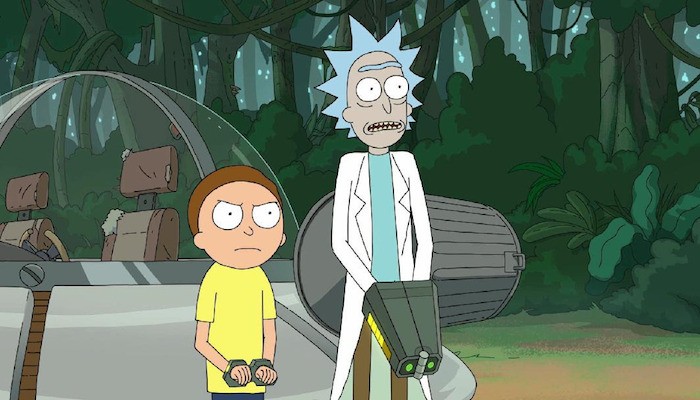
Unlike other classic Mentor-Hero combinations, the relationship between Doc and Marty has a dynamic twist to it – it’s more Batman-Robin than it is Gandalf-Frodo.
Their interaction changes as they learn from each other, Marty bringing his unique information from the future,

and Doc pairing it with scientific knowledge and the technical power to make it work.
I find especially interesting the way they inspire each other: in 1955, Doc Brown has his own hero’s journey to make, and Marty is his mentor.
After the initial refusal and shock,

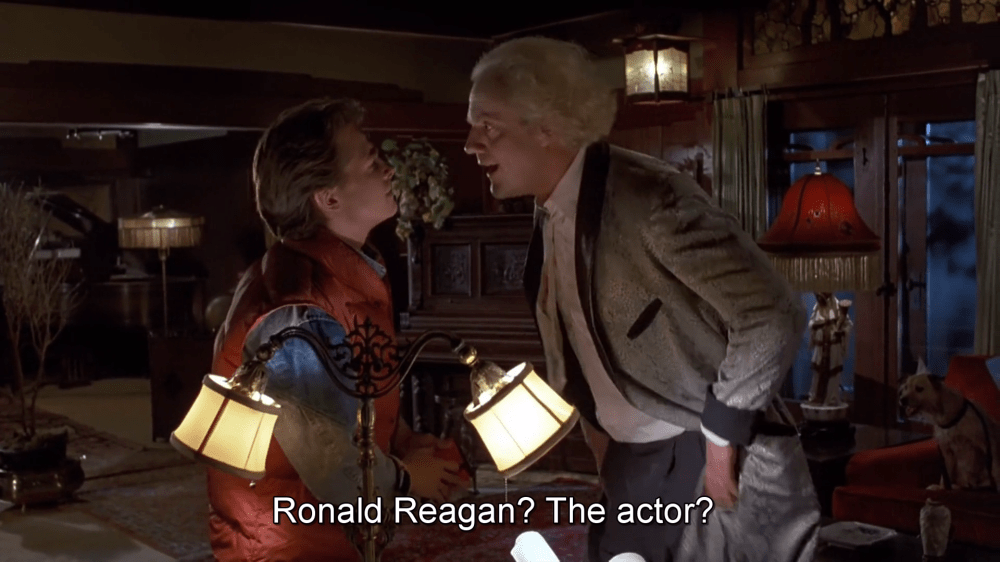
Doc finally gets to accept the challenge,
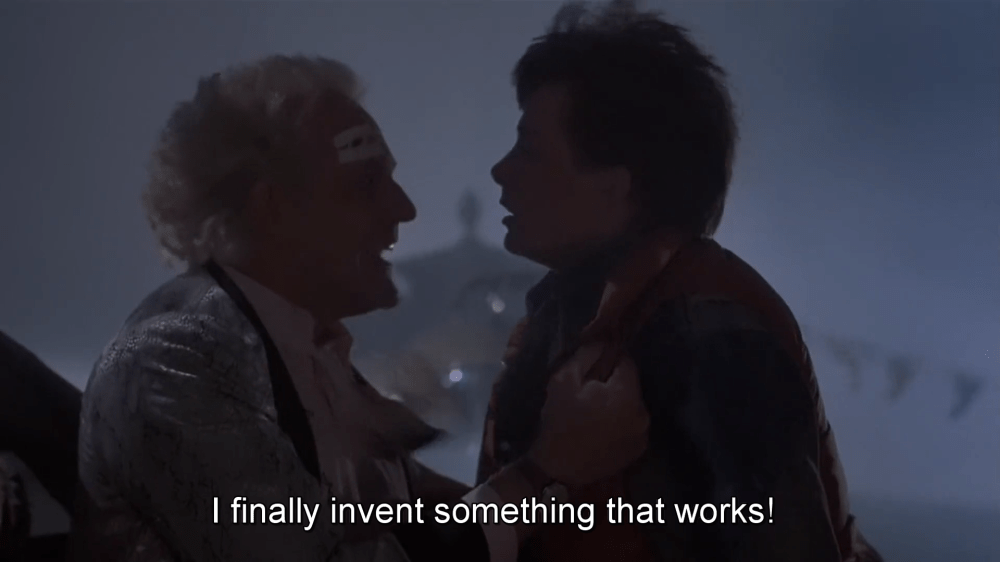
because Marty gives him the much needed reassurance that one of his inventions will eventually work!
(Thus potentially setting in motion the series of events that will make it happen at the end, but that’s the beauty of temporal paradoxes).
So we have a plot that unfolds on two levels. Marty’s arc embraces the whole of the events; but in the process he inspires Doc’s in his mini-arc (also about gaining self-confidence) and George McFly too.
It’s a Russian-dolls structure, which is why the story is so gripping and satisfying.
(And yes, it’s all about the boys. We will get there).
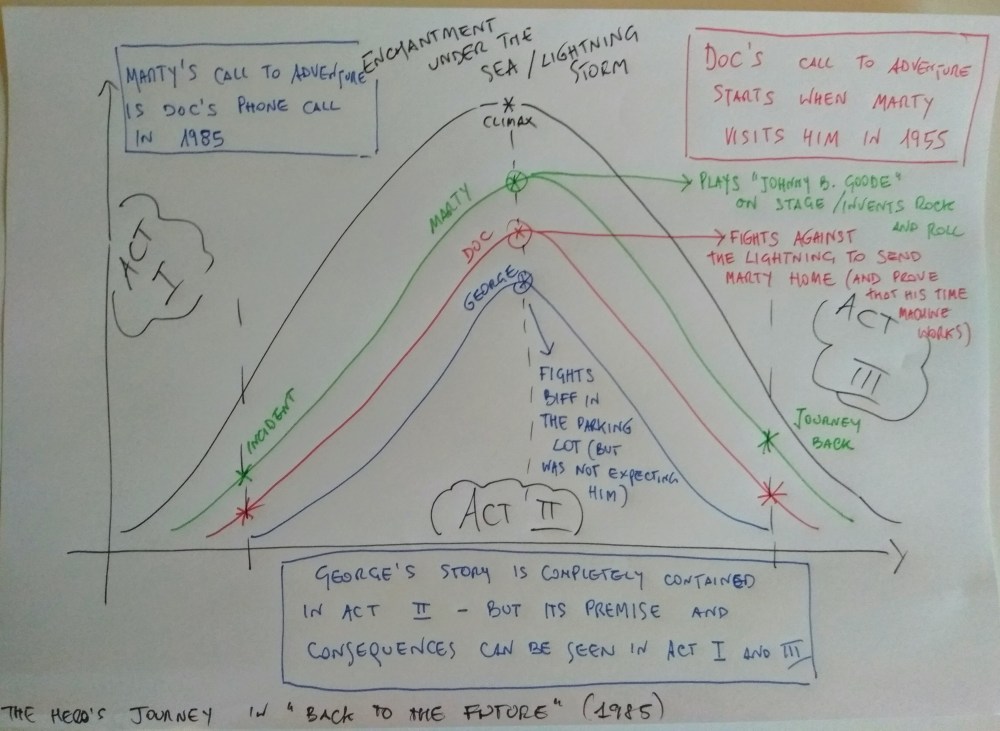
Marty learns to fight against adverse circumstances.

And while it is Doc who develops the plan to harness a lightning’s energy to get the 1.21 gigawatts necessary to send Marty back home;
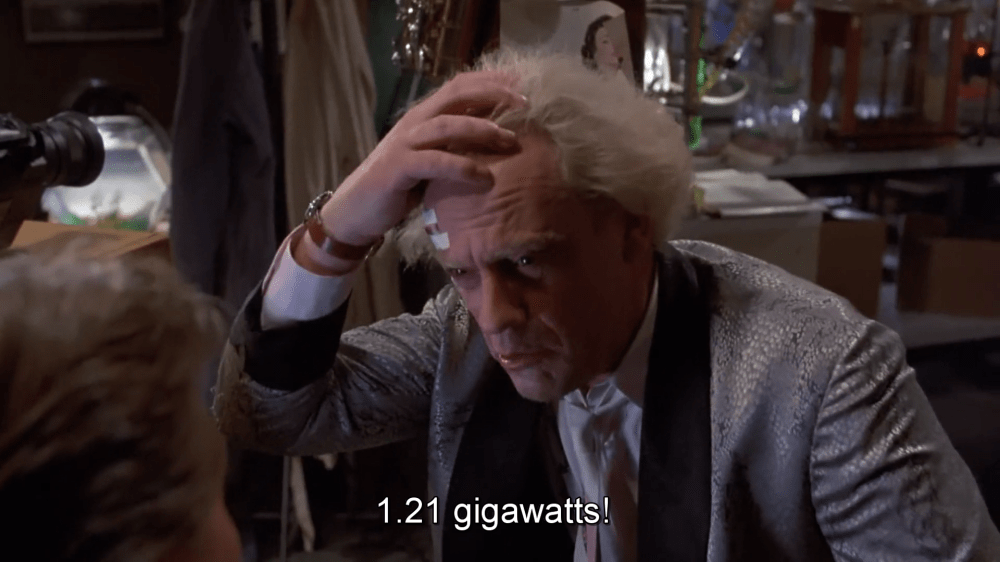
it is Marty who brings the precise information of where and when will the lightning strike. And finally, Doc saves Marty’s life by enabling him to return home safely.

But Marty later will do the same by revealing him the details of the strike by the terrorists that will (would?) get him killed.
All in all it’s a very dynamic, fruitful relationship that is always under tension, captivates the audience and keeps the story move fast.
6) Back to the story.
Marty progresses through the journey using his talents (he is brave;

he is good on a skateboard (because he probably invented it),

and he possesses valuable information and gadgets from the future that will help him to get out of trouble
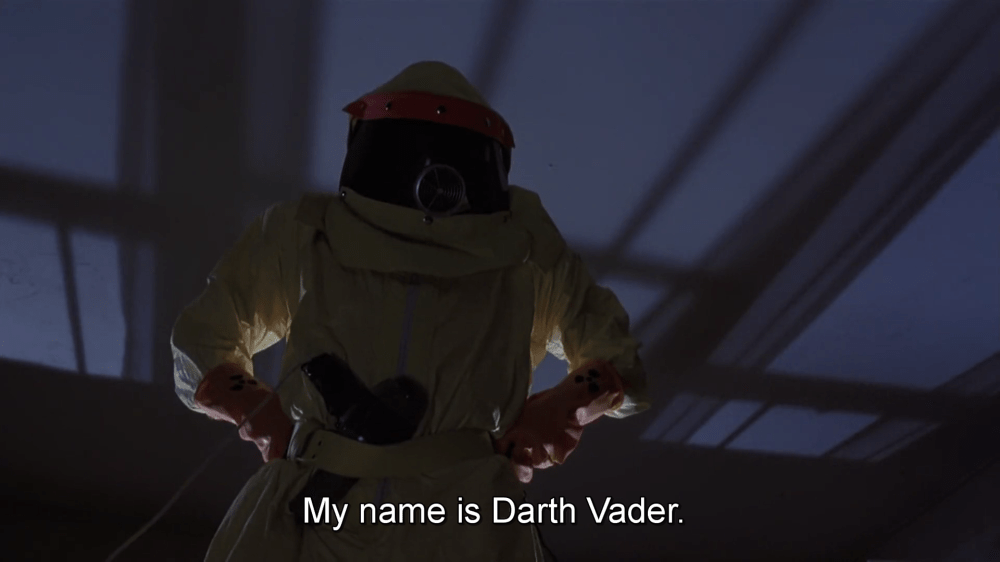
But he also has much to learn. In a defining scene, he discovers that his father suffered exactly from his own character flaw: fear of failure.

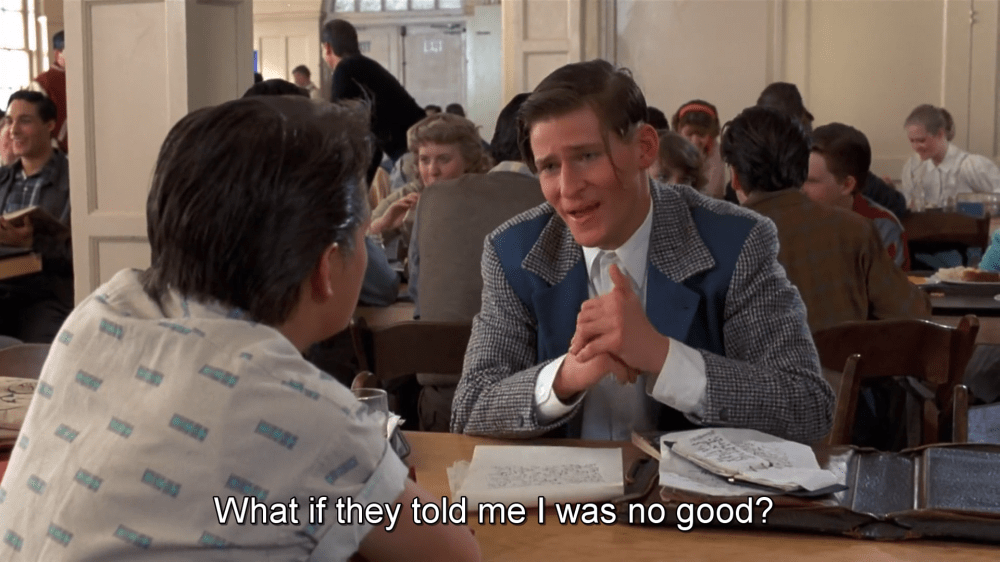
So here the theme of the story is stated for a second time, and reinforced.
His powers will also sometimes backfire against him: his attempt to learn more about his dad makes him end up in his mother’s bedroom for one genuinely awkward moment of familial love;

and his willingness to stand up against the bully makes it even worse, as Lorraine starts to fall in love with him inexorably.
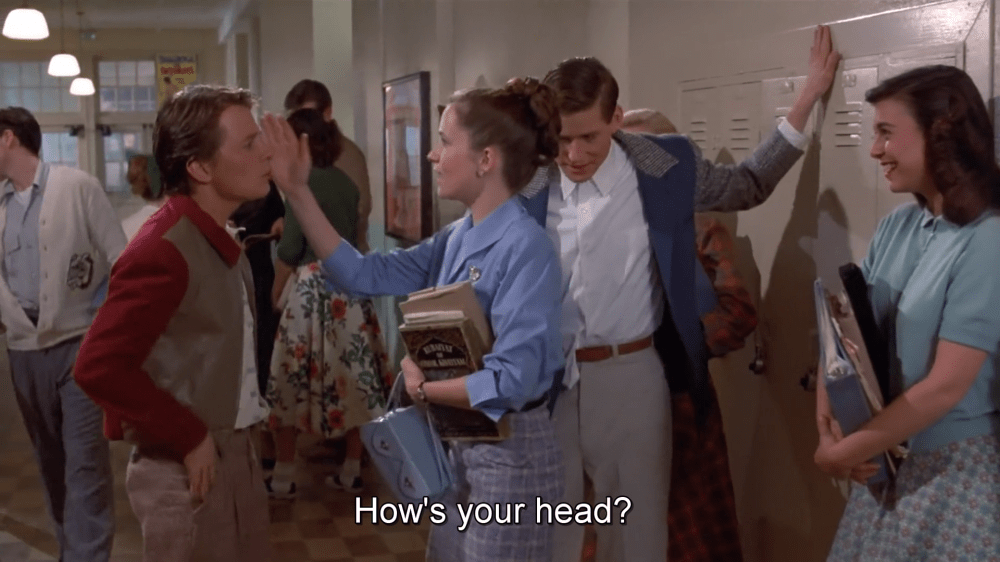
7) Time to go deep.
As the story unfolds with a combination of hit and miss, the Dark Cave moment approaches. It is represented (again, not so very subtly, right?) by the aptly named school soiree Enchantment Under The Sea. Here Marty’s parents are supposed to kiss for the first time, and fall in love. As Marty watches in terror as he and his siblings fade away from his family picture (and from existence), he devises the cunning plan to take Lorraine out for a date, behave horribly, and let George step in and save the day.
Here Marty is being a Mentor for his own father.


So, the big Saturday night comes. It’s the night of Enchantment under the Sea, and also the night of the lighting strike that will send Marty (hopefully) back to the future.
Marty is having a very… revealing encounter with his mother, Lorraine
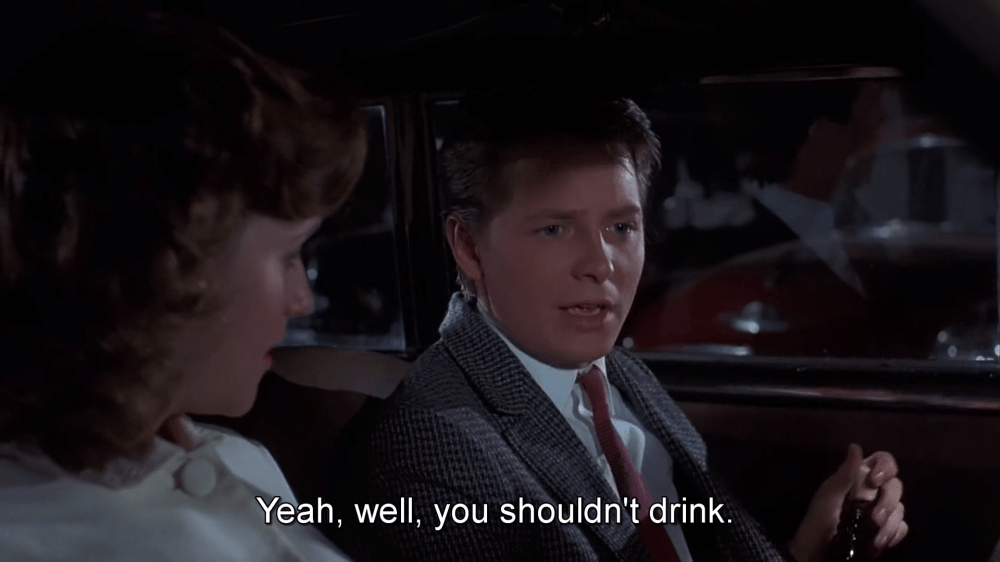

but then, at the decisive moment, the plan goes all wrong.
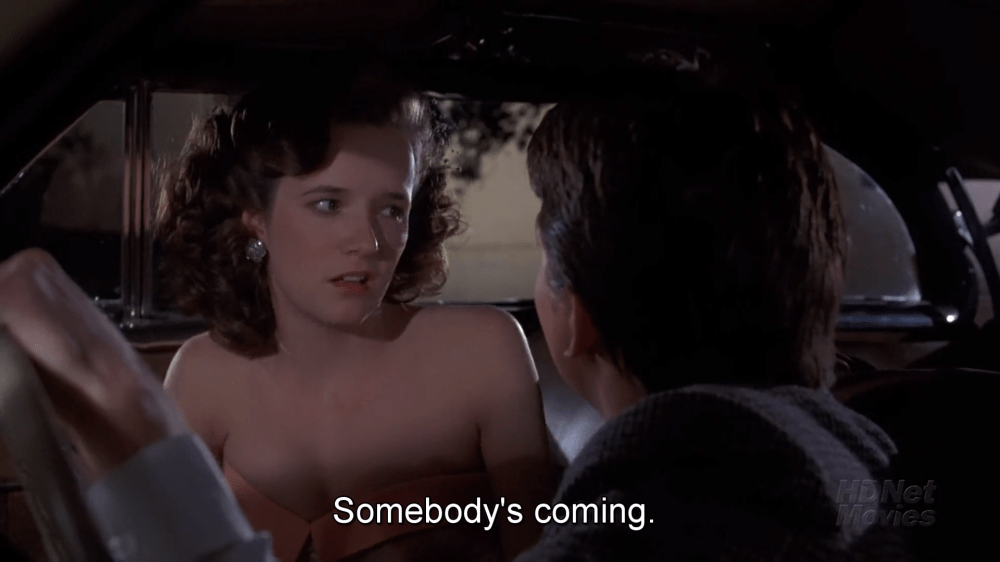
When the car door opens, it is a very angry Biff who appears, ready to make things much worse.
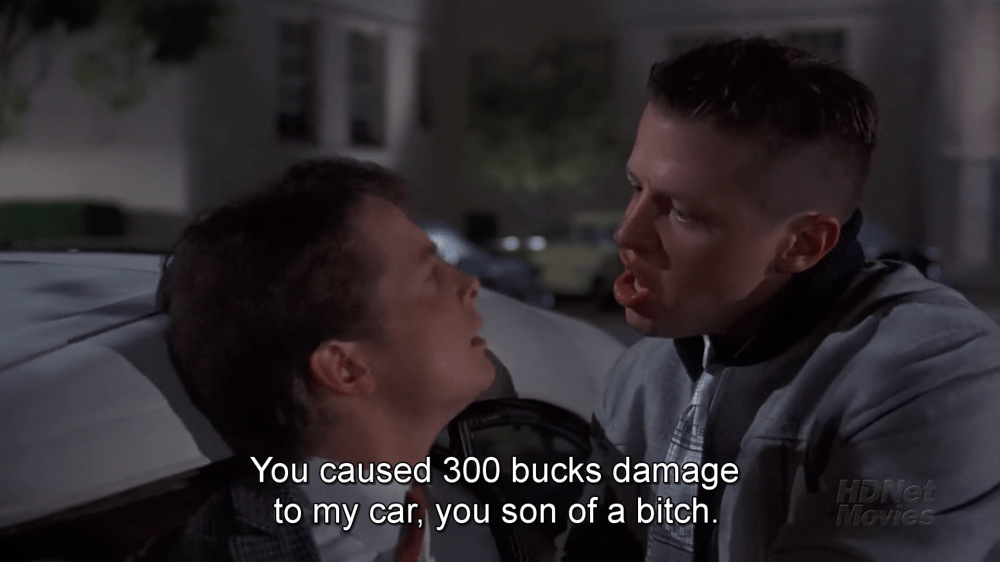
Marty is locked in the trunk of a car, and the situation couldn’t be worse.
Now, the moment of Dark Cave, is when Back to the Future really shines. In the same thrilling sequence, two narrative arcs gets resolved: George, who will have to summon all his courage to face Biff and save Lorraine from real danger,

something that was definitely not part of the plan

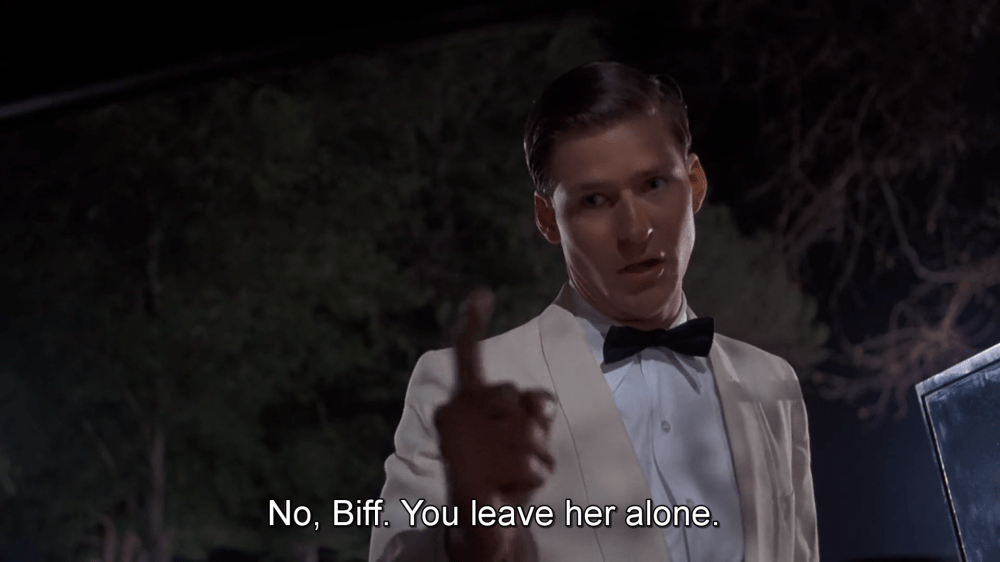
George’s arc is complete when he passes through a re-test: another local bully who tried to invade his personal space and needs a lesson in manners.
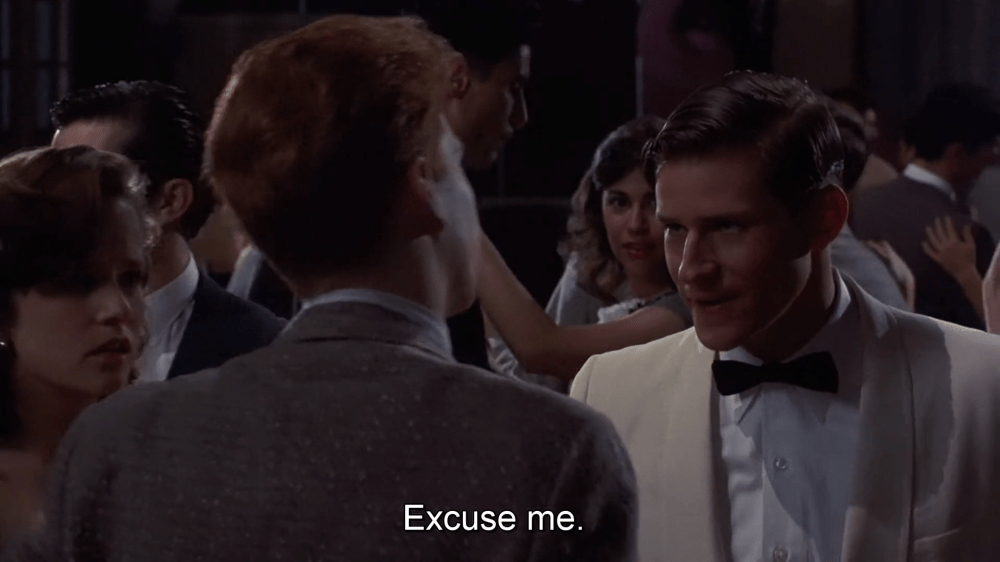
Parallel to this, Marty’s ordeal: he will have to stand-in for an injured musician, faces his fears and gets on that stage to play for the school dance after all,


And in the process, he probably… also invents rock and roll!
8) Your kids are gonna love it.
It’s the final moment of the Reward and Inspiration, when the meaning of the Journey is starting to become clear for all those involved… maybe even too much?
Marty casually mentions “kids” from the stage, George and Lorraine seem well on their way to form a couple, and Marty even tells them not to be too hard with one of their children. The story is seeding in the audience’s awareness the idea of future consequences ( = children), and it connects perfectly with the plot theme established earlier on (to change history).
And at the same time, we realize that in this version of 1955, something didn’t go exactly as in the historical facts, so we can feel that some details are slightly out of place. Just a feeling, maybe?
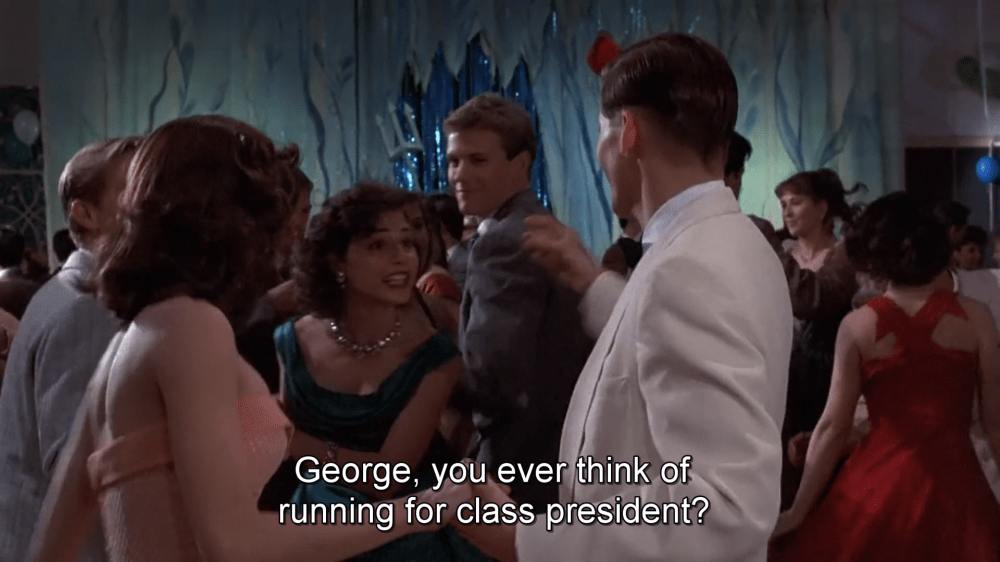
But there is no time for these questions.
The story proceeds at breakneck speed towards its emotional Climax. Marty is late but makes it on time to meet Doc Brown in front of the city hall. They barely have time for a few last words of goodbye, the big storm is brewing, and Marty would so much like to have an opportunity to exchange a few last words with his friend! He needs to warn him about the danger of cheating the terrorists!
First, he tries to give him a warning letter. But Doc refuses to even open it.
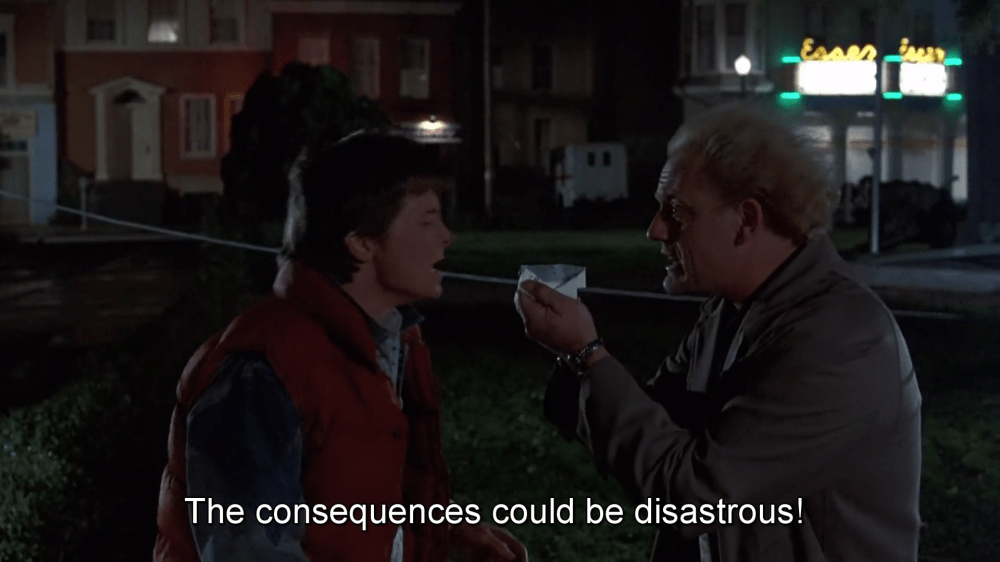
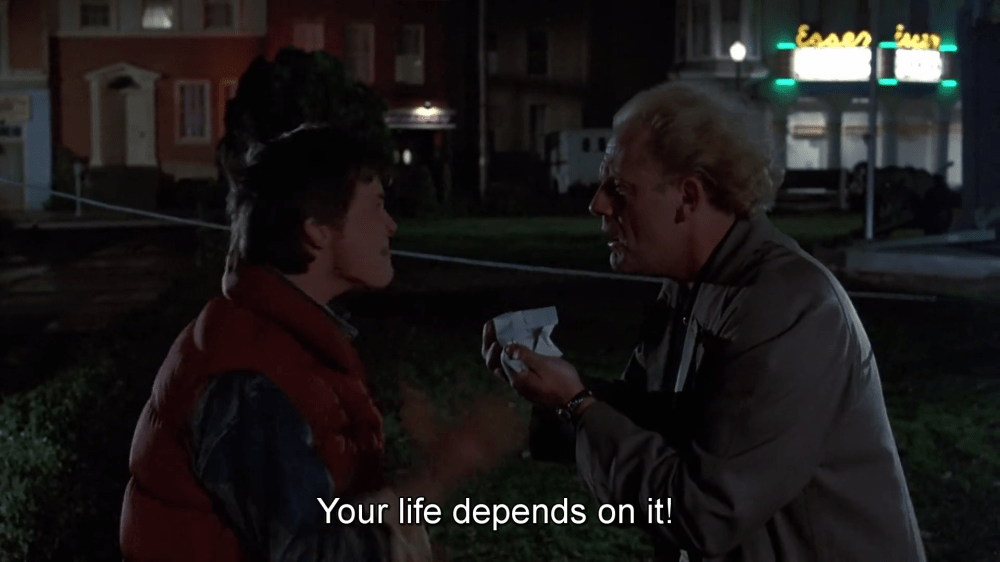
So Marty decides (again) to cheat a little. He is in control of his game, now. Or so he thinks.
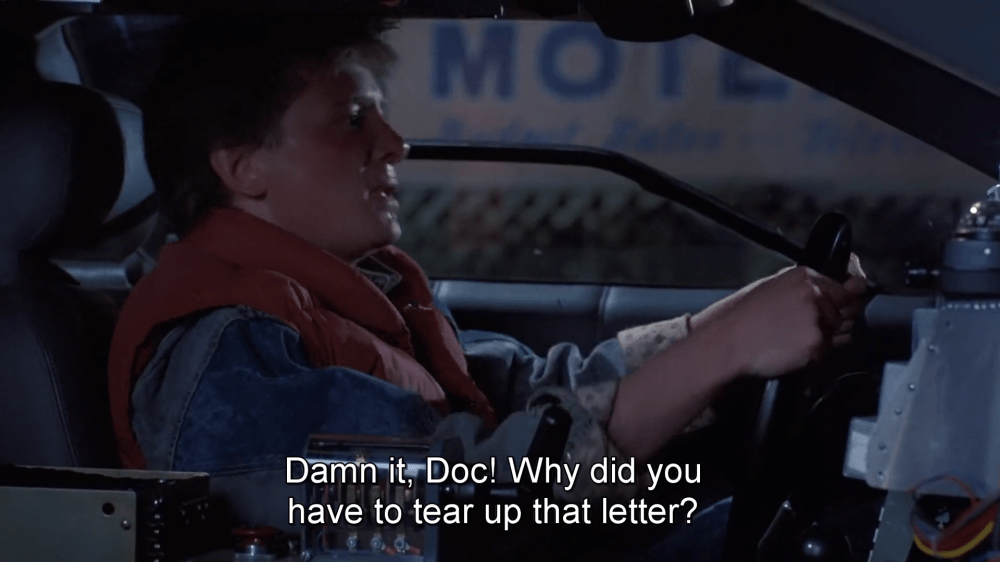
After all, his Journey taught him that sometimes the limits are there to be stretched a little. So he sets his clock ten minutes in advance, just enough to meet Doc in 1985 and save his life.
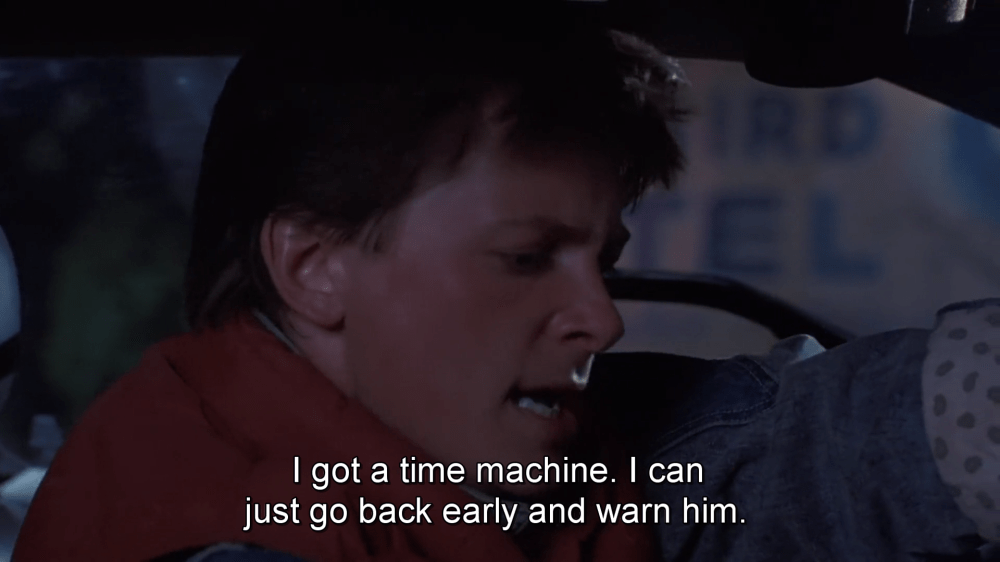
Well. It’s time for the last moments that our heroes spend in 1955.
9) I will send you Back to the Future!
It’s time for The Journey Back Home – not without a few suspenseful moments when, again, our heroes will have to put in a little extra effort because nothing ever goes according to the plans.
But in the end, it all works!

The lightning strikes exactly in the moment when Marty is passing, and in a ball of fire and light, the Delorean is sent back to the future. Exactly when he wanted: 10 minutes before the fatal accident that would take Doc’s life.
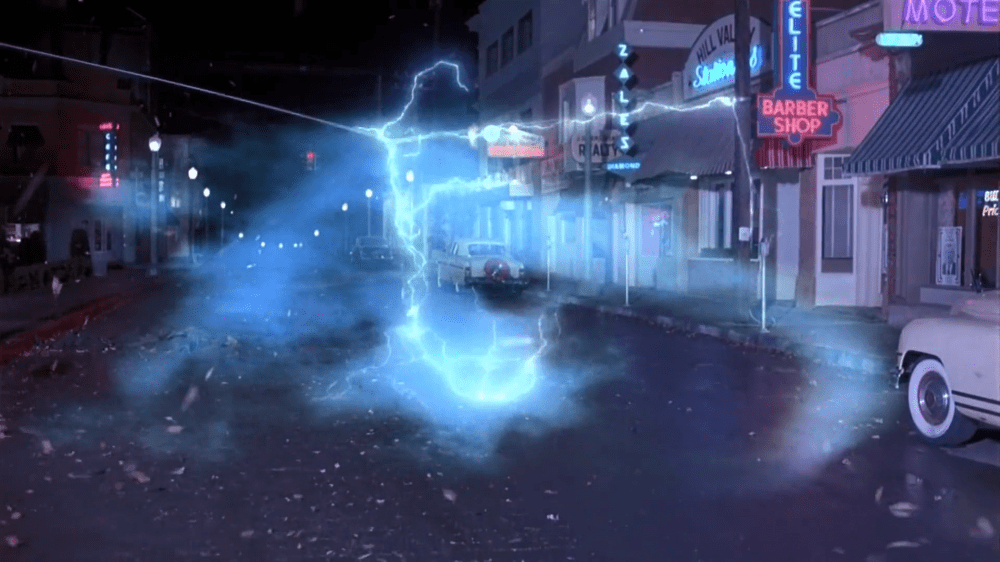
Except, once again, Fate interferes. The car won’t start. Again.
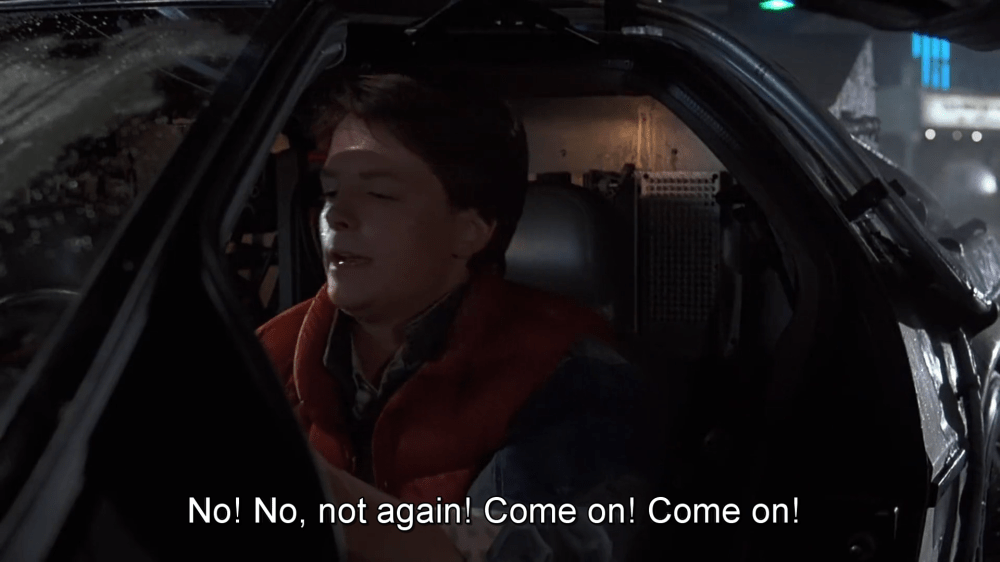
It is almost as if Time has a special resistance of its own against change, and folds reality so that it is especially hard to change the flow of things. Maybe it’s just coincidences; maybe something more.
In “Back to the Future” this idea is presented only as a hint, subliminally (Marty never gets to meet himself, so to prevent some possible time paradox), but it is a concept that will be explored for example by Stephen King – again, His Majesty the King – in “11/22/63″. Really, read it: it’s so good.
Marty has no other choice but to reach the place of the meeting on foot. He runs to the Mall – which is now called “Lone Pine”, since only one tree survived the 1955 incursion by the Delorean.

Marty doesn’t notice, he is too busy witnessing – again – the death of his best friend-slash-mentor. Too late!
He can just barely witness the old-new version of himself jumping into the car to escape the terrorists, hit once again the fateful 88 mp/h and… whoomp!

But this time we get to see what happens next. The bad guys lose control of their van, which hits a telephone booth, and they seem K.O.

Time to check what’s the status of Doctor Brown… and to everybody’s surprise and relief, find that he was wearing a bulletproof vest! He decided to read Marty’s letter, after all.
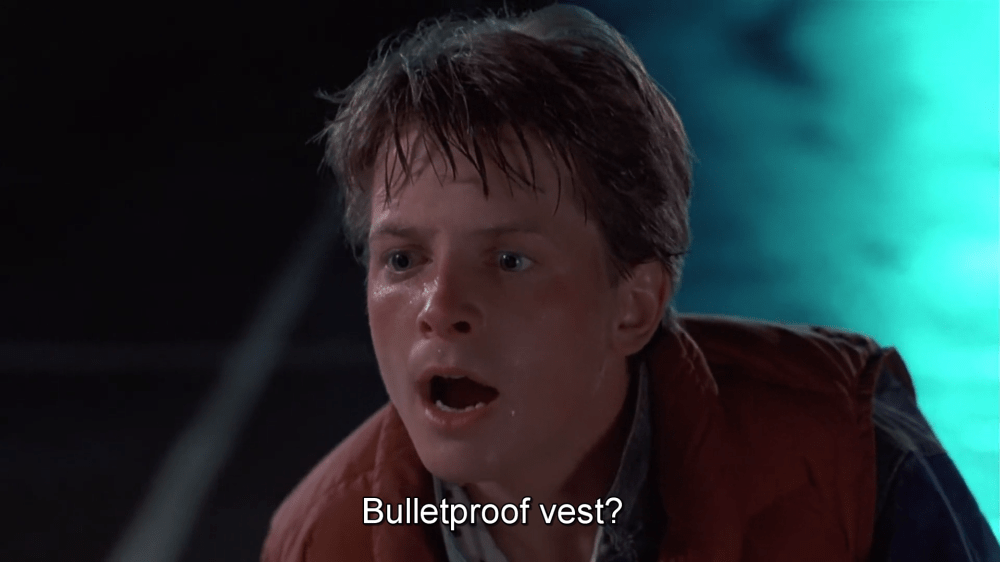
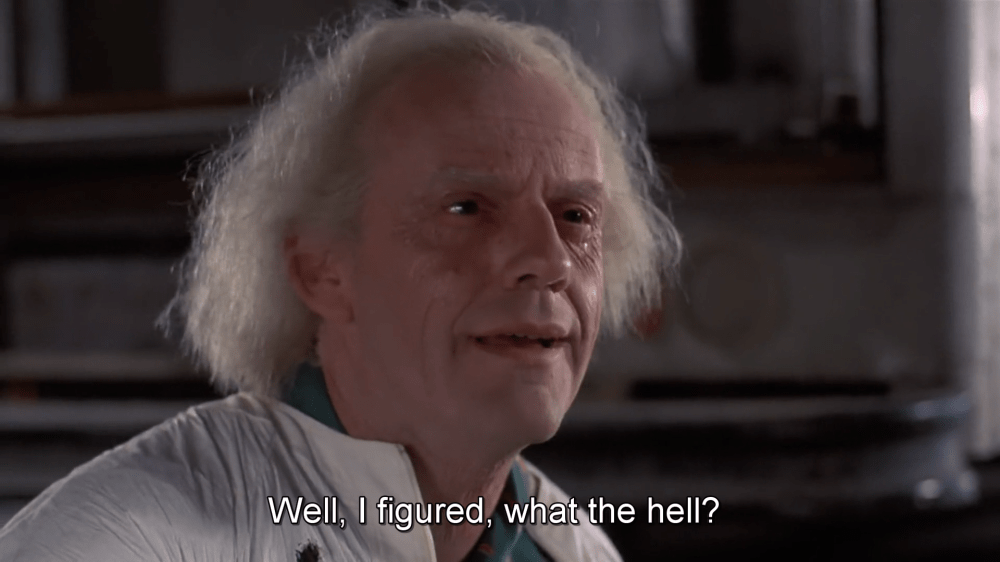
so yes, risking a time-space anomaly but at the same time, saving his own life.
10) Same-same, but different.
Talking about Death and Rebirth. And this concludes also Doc Brown’s arc. He has learned that rules can be bent, sometimes.
This is the culminating moment and the Resolution of the story – the heroes have learned their lessons, and they have returned to the Ordinary World with a higher state of knowledge and existence.
For Marty, the Journey was about testing his personal limits, learning how to deal with rejection and difficulties when “no” cannot be taken as an answer, and learning to love his parents even with all their faults; but in the process, the journey inspired great change also in other people’s lives.
Doc Brown has learned that sometimes rules can be broken for a higher purpose, and most importantly gained trust in his own inventions – creating a fascinating circular paradox based on the mutual influence that the events of 1985 have on 1955, and vice versa.
And George has learned to fight for his goals, and not to be afraid to express his creative potential. From a shy boy who never lets anybody read his stories, he becomes a confident man, a successful author and a role model for his family.
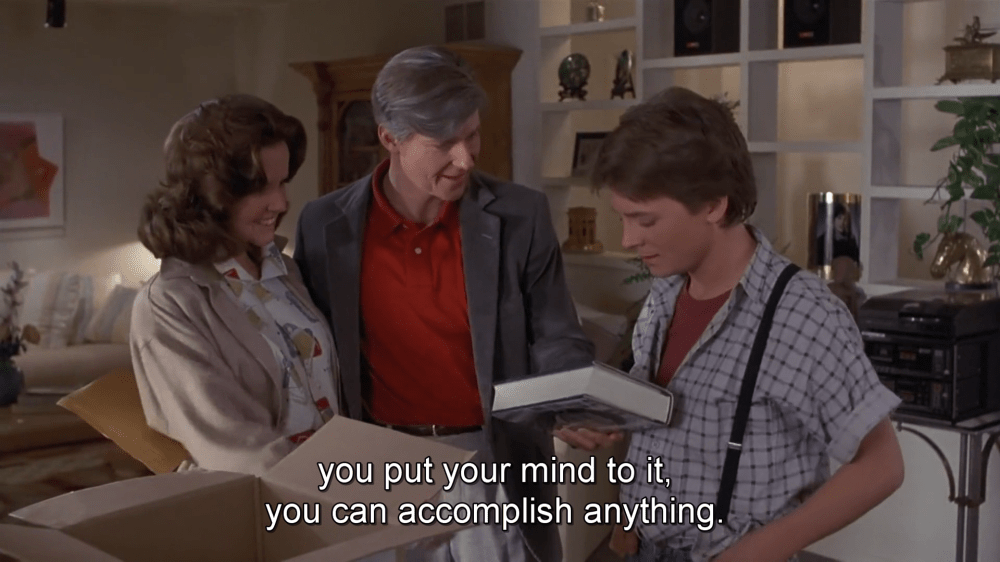
The scene sets when Marty meets his new / old family, and his surprise to see how better everybody is doing, as a result of his adventures in 1955.
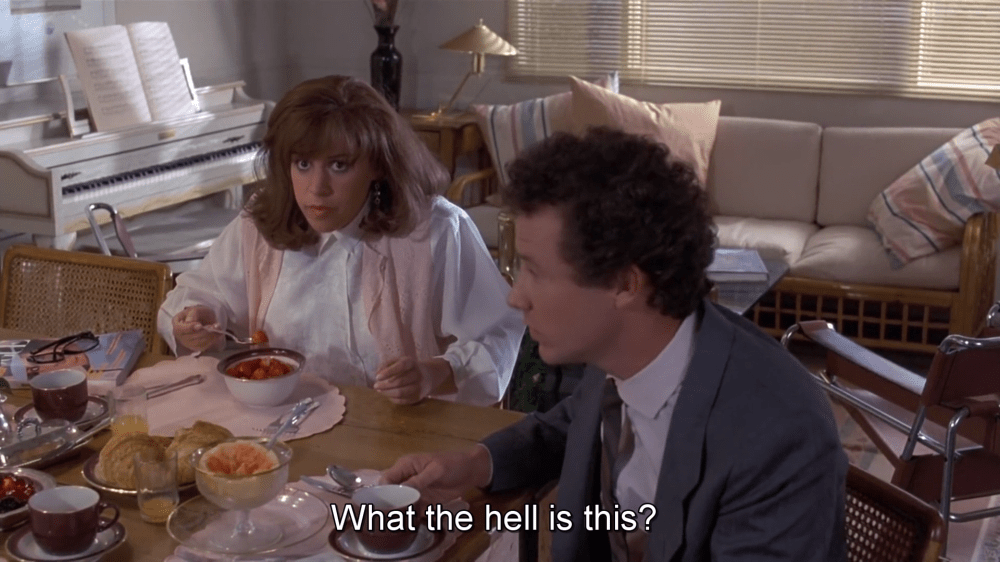
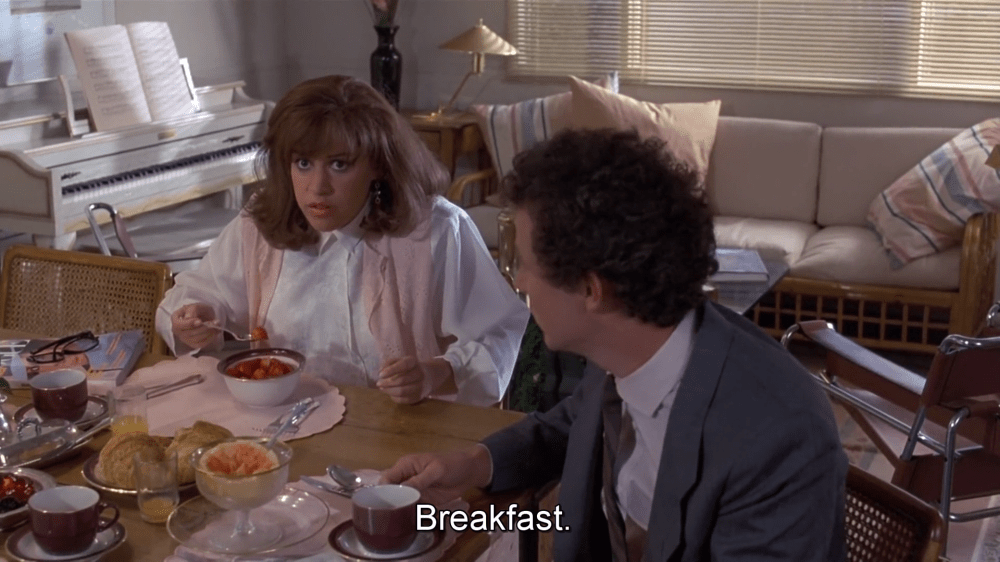
We also get to learn that in the new future, Biff is not the town bully anymore.
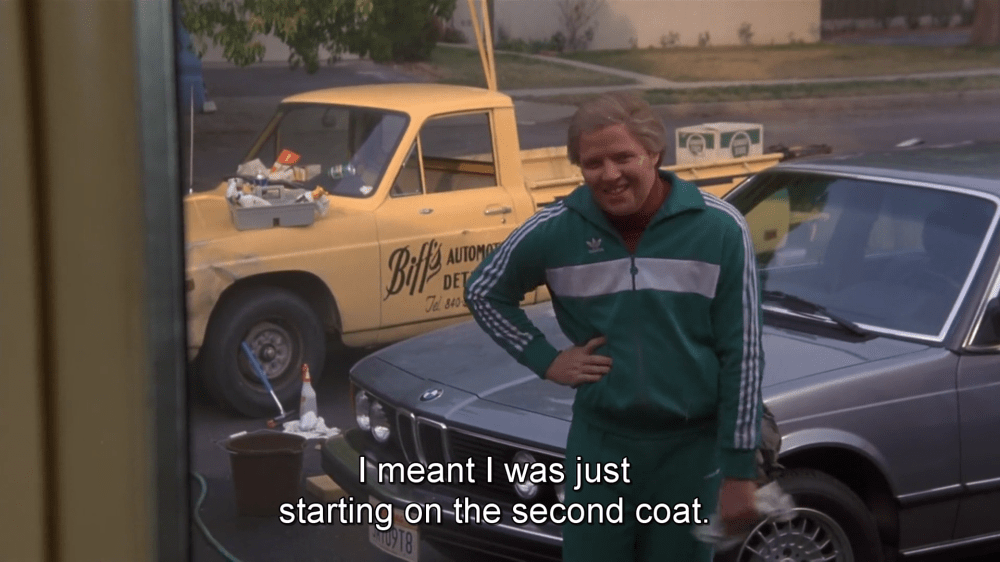
Ah yes, and also the inevitable hook to the sequel, where the Hero’s Journey will have to start over again- and the legendary quote “roads? where we are going, we don’t need roads“.

And this naive idea that in 2015, cars will fly? Spoiler: they really don’t.
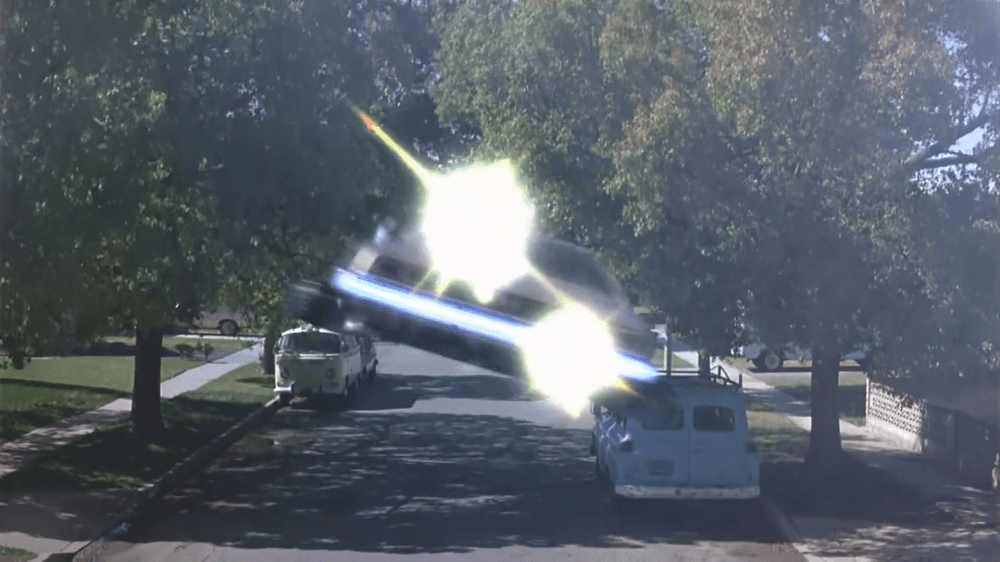
So this concludes our analysis of “Back to the Future” seen through the lenses of “The Hero’s Journey“.
All in all, a film which borrowed atmospheres and themes from different sci-fi sub-genres and from the “Twilight Zone“, but did it in a very personal and fresh way, resulting in a monumental impact on popular culture as a whole (see all the references in Spielberg’s “Ready Player One” from 2018).
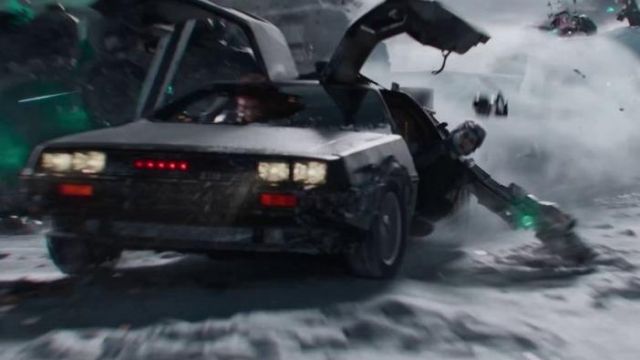
It is still a perfectly enjoyable movie, with clockwork narrative mechanisms (not strange, given that “time” is so central to its theme), overall good acting performances and a memorable, iconic soundtrack by Alan Silvestri.
Some of its aspects didn’t age too well, in particular the way the story deals with anything that is “other” from the cultural point of view of the protagonist.
For example:
- the “terrorist” Libyans, just a little more than villains from a B movie, as we mentioned;
- African Americans, despite one character being Mayor of Hill Valley in 1985, his 1955 version doesn’t get further than comic relief – completely skimming over the time of deep social turmoil that was about to come;

- the female presence in the story is almost marginal: Jennifer is really uni-dimensional, and acts only as an inspiration and motivating factor for Marty; while Lorraine-mother unfortunately does not receive adequate depth and ends up only reinforcing some stereotypes about… uh, mothers and women in general, which is a pity (ok, the story is set in small-town America in the 50s, but still, this aspect could have been given more thought);

- the Villain and his henchmen, who receive only a bi-dimensional treatment and remain relegated in a functional role of “bad guys” and sometimes tricksters who get to spin things around a bit. We never get to learn anything about their motivations and background – a fault in general for a story that is about inspiration and positive change.
But these notes are still somehow kept out of the focus thanks to the overall tone of lighthearted cartoonish buddy-comedy, with slapstick elements and hints of social satire and parody.
For a more mature representation of the historical and social period, one should look elsewhere.
But for an entertaining tale of challenge and growth, a modern take on some classic themes, and 2 hours of generally breathless and exciting time, “Back to the Future” is still as good as ever. It is, after all, a 1985 movie that was and remains an all-time classic.
*
Did you like this analysis? Do you agree? Not at all? Let me know! Write in the comments and share the article with your friends and readers who might be interested. It’s the best form of reward for me :)
I really enjoyed this. Fantastic read. Insightful!
LikeLiked by 1 person
Thank you!
LikeLike
>Why a Volkswagen van?
as far as i remember, in all action movie in that times, the bad guys/terrorists/etc use this type Volkswagen van. the car itself connected with bad guys in the viewers. In hungary, even the ‘public nickname’ was ‘terror bus’ for this VW van!
LikeLiked by 1 person
That is cool! Thanks for the tip
LikeLike